1
Between 2008 and 2015 the contemporary photographer Thomas Struth made a number of large color photographs of technological and scientific subjects, twenty-five of which (or more, depending on how one counts) were included in the exhibition titled Nature and Politics that for two years (2016-18) traveled among museums in Essen, Berlin, Atlanta, and St. Louis. (There is a comprehensive catalog with excellent illustrations of all the photographs.)1 Struth refers to them as his “technology” photographs, and I shall follow him in this. I’m not sure exactly when I saw a few of them for the first time, but from the start I found them compelling, and over the years, in galleries in this country and abroad, I watched the series ramify and develop. What I want to do in this essay is look closely at a number of the technology photographs in an effort to explain exactly what it is that makes them singularly gripping (to me, anyway) at the present moment (time of writing: summer 2016) in the evolution of the contemporary “visual” arts.2
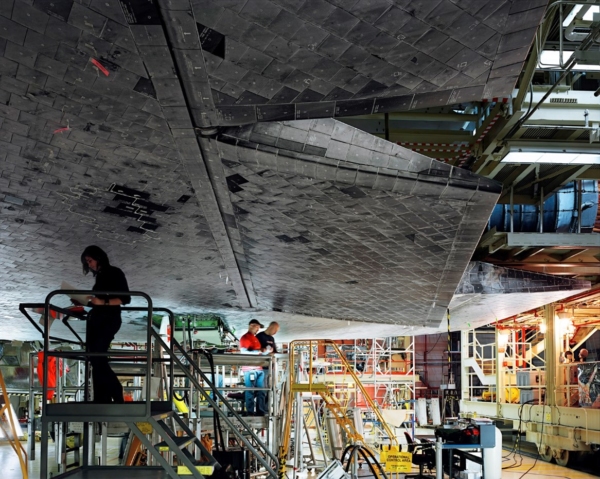
Let me begin by glancing at one of the first in the series, Space Shuttle 2. Kennedy Space Center, Cape Canaveral 2008. Right off, it calls to mind a large and impressive photograph by the Canadian photographer Jeff Wall, Restoration (1993), which depicts youthful restorers at work on the so-called Bourbaki Panorama in Lucerne. (The 360-degree panorama by Edouard Castres depicts a scene from the Franco-Prussian War, the arrival in Switzerland of the starving and exhausted remnants of the French Army of the East led by General Charles-Denis Bourbaki.) The two photographs differ in format, Wall’s being quasi-panoramic in its own right, but the basic idea of depicting a woman restorer on an elevated platform has much in common with Struth’s composition of fifteen years later. I have to assume that Struth was aware of this and at the very least was willing to accept the comparison.3 As we shall see, Struth’s technology photos are in implicit dialogue both with earlier series in his own oeuvre and with the work of other photographers, not just Wall but also, especially, Struth’s younger contemporary, Thomas Demand.
For me the deeper interest of Struth’s photograph is thematic: the upper half of the composition is dominated by the under-surface of the Space Shuttle with its diagonal grid of heat-defying ceramic tiles; the implication is that the young woman in the left foreground and perhaps also the two men farther back and to the right are working on these. That they are doing so is nothing less than a matter of life and death. That is, it is absolutely crucial to the success of the Shuttle’s missions and the survival of the astronauts inside it that the tiles resist the formidable heat of reentry and even more that they do not come loose from the surface of the Shuttle. This may seem to go without saying, and in a sense it does, but taking this photograph as thematic for the series as a whole (as its position early in the exhibition catalogue encourages one to do), it also suggests that there will be no tendency in the series to shift the implied locus of agency away from human beings to the technology itself—a point driven home by the fact that this is the only one of the technology photographs to include human agents. And this means that the technology photographs will have nothing whatever to do with any so-called “vital materialism” such as that espoused by political scientist Jane Bennett and other theorists of her inclination, which would seek to minimize the role of human agents in any consideration of human/technological interaction in the direction of the so-called vital capacities of the technology as such.4 Thus Bennett supports Bruno Latour’s notion of “distributive agency,” a feature of his so-called “Actor-Network theory,” according to which Latour “strategically elides what is commonly taken as distinctive or even unique about humans” (ix). As she also remarks, she wants to highlight “the agentic contributions of nonhuman forces . . . in an attempt to counter the narcissistic reflex of human action and thought” (xvi). (By which she means she wants to counter the basic distinction between animate subjects and inanimate matter. All this she imagines as ultimately a political project designed to include material objects in a larger conception of the polis.) I find such arguments unpersuasive, not to say absurd, but they have found traction in various precincts of the academy in the United States and abroad, and it seems important to put them out of play from the start. More precisely, I take Struth’s Space Shuttle 2 as performing such an operation—as establishing certain basic parameters for coming to terms with the photographs that follow. This would be one implication of his allusion, if that is what it is, to Wall’s Restoration, another image of human beings repairing a material artifact.
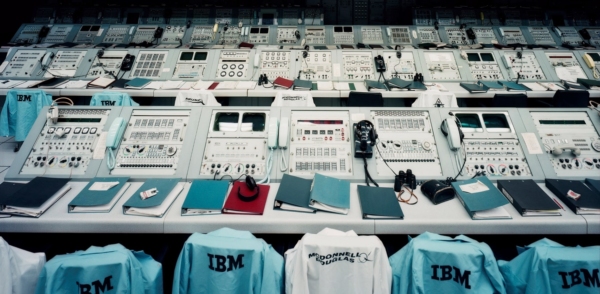
It is not surprising, therefore, that the very next photograph in the catalogue, Control Panel, Kennedy Space Center, Cape Canaveral 2008, makes a point of the same issue of agentic control by showing us three lateral rows of individual control panels, all bearing evidence of their absent human occupants (looseleaf binders, binoculars, earphones, etc.), with chairs bearing on their backs lightweight jackets with the designations “IBM,” “McDonnell Douglas,” and “Boeing”—but with no humans in sight (the rule from here on out). Yet there is not the slightest implication that the control panels are capable of operating on their own. Indeed it is as though Struth is deliberately emphasizing the issue of control in these early photographs, by way of clearing the ground interpretively for what will follow.
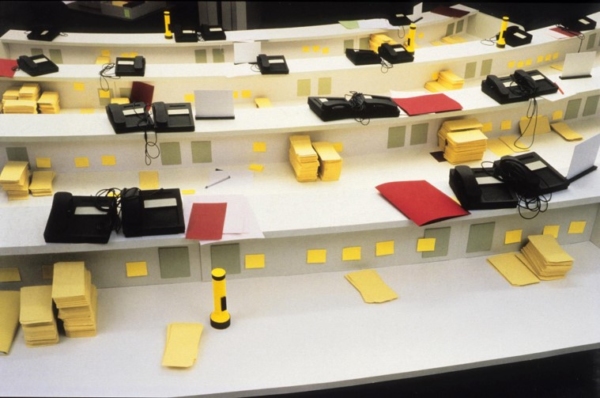
And something else: Control Panel, Kennedy Space Center may be seen as alluding to a well-known earlier photograph by Thomas Demand, Poll (2001), which was based on media images of the Emergency Operations Center in West Palm Beach, Florida, where in November 2000 election authorities went through tens of thousands of ballots in an attempt to determine whether Albert Gore or George W. Bush had won the state and hence the national election. (Eventually, of course, the count was halted by a decision of the Supreme Court and the election handed to Bush.) As by now is widely known, Demand’s photographs begin by reproducing in paper and cardboard, most often at full scale, a scene, place, or situation known from media images and then photographing with a view camera the model that results. (Demand began as a sculptor and thinks of the models as sculptures of a sort, given definitive form by the photographs of them; this will be of further interest to us.) Invariably, the paper and cardboard models are at once meticulously made and visibly flawed, lacking important details (in Poll all the ballots and post-its are blank, the telephones lack numbers on their faces, and there is no room for seats between the curving rows of desktops), so as to leave the viewer in no doubt as to what he or she is looking at—a photograph of a model rather than of an original scene. The question that must then be asked is why Demand chooses to proceed in this extremely labor-intensive way, and my answer, first put forward in my book Why Photography Matters as Art as Never Before (2008), is that by so doing he is able to accomplish two complementary purposes: first, to present images of places and objects that have been rigorously purged of every causal trace pertaining to the original situation; and second, to replace those traces with marks and indices of his own process of making, which is to say “to replace one or more mediatic images of [a particular place or situation] with a counter-image of sheer artistic intention, as though the very bizarreness of the fact that the places and objects in the photographs, despite their initial appearance of quotidian ‘reality,’ have all been constructed by the artist throws into conceptual relief the determining force…of the intentions behind them.”6 (More on that too further on.) Seen in this light, Poll is virtually an allegory of Demand’s basic project, in that what took place in the Emergency Operations Center was a days-long attempt to determine the intentions of a substantial number of Florida’s voters, whereas the photograph makes visible—it exists to make visible—no intentions other than the artist’s own. More broadly, Demand’s photographs invite being understood as thematizing intendedness as such, an aim that locates them at the farthest pole from the emphasis on indeterminacy—the idea that the meaning of a work is nothing other than each viewer’s subjective experience of it—that has been a staple of postmodernism from the very start. (A large topic, needless to say, from which I will draw back. My profound disagreement with the indeterminacy position goes back to the critique of minimalism/literalism in my 1967 essay “Art and Objecthood” and indeed earlier.)7
Shortly it will become clear why the digression on Demand was necessary. At the very least, though, we can say that Struth’s Control Panel stands in a kind of dialectical relation to Demand’s Poll by virtue of supplying the sorts of real-life details that the earlier work systematically elided.
2
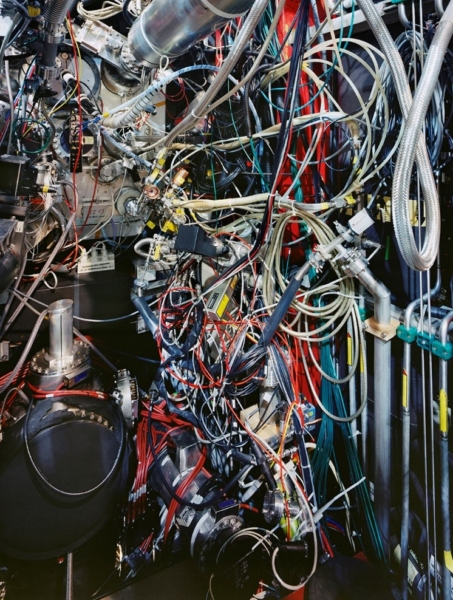
We come now to one of the first technology photos that initially caught my attention, Tokamak Asdex Upgrade Periphery, Max Planck IPP, Garching 2009. Garching is a recently created city near Munich, and a tokamak is a device for producing nuclear fusion by containing the super-heated plasma (the fourth fundamental state of matter after solids, liquids, and gases) based on heavy hydrogen (i.e., the isotopes deuterium and tritium) within a powerful magnetic field. Obviously the photograph shows us only a portion—presumably a small portion—of the entire device; equally obviously, Struth cannot have expected his viewer to know even approximately what they were looking at, or even, having read the title, to know what a tokamak is. (My knowledge, needless to say, has been gleaned from Wikipedia.) What the viewer does understand, however, is that they are in the presence of a photograph of an extraordinarily complex piece of equipment, one comprising an uncountable number of tubes and wires as well as a host of subsidiary devices, with none of which the viewer is familiar, all assembled and connected with one another in immeasurably complex ways. Put slightly differently, the viewer realizes at once that what they have been given to see goes far beyond their power to take it in, no matter how long or with what effort of scrutiny they give themselves over to the image.
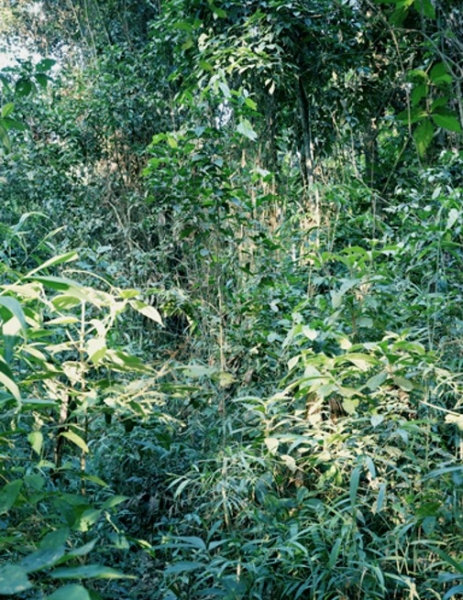
In this regard the technology photographs—taking Tokamak Asdex Upgrade Periphery as characteristic of them as a group (or at least of a subgroup that particularly interests me)—bear a close relation to an earlier series by Struth, his Paradise photographs (1995-2008), in which, as he put it in an interview with an art critic for the British newspaper The Guardian, “everything was so complex and detailed that you could look at them forever and never see everything.”8 (We are looking at Paradise 28 [2005].) As he earlier remarked, the Paradise photographs “contain a wealth of delicately branched information, which makes it almost impossible, especially in large formats, to isolate single forms. One can spend a lot of time in front of these pictures and remain helpless before them.”9 For Struth, the further import of those photographs is “spiritual”—as I wrote in Why Photography Matters, “the pictures in his view ‘emphasize the self’ and provide occasions for meditation and internal dialogue” (WPM, 300). But I also suggest that the viewer is in effect distanced and excluded by such imagery, as if Struth in that series were seeking to go against his own natural impulses by bringing about “a different, resolutely non-empathic relation between picture and viewer” (WPM, 299).
If we now return to a consideration of Tokamak Asdex Upgrade Periphery, several points begin to emerge. As some have noted, it and other photographs like it are characterized by a degree of internal complexity comparable to that of the Paradise photographs. But there are crucial differences between the two series. For one thing, whereas in the Paradise pictures the foliage in a variety of greens creates a dense screen that effectively resists our acts of seeing, a photograph such as the one we are looking at—close-up, high-definition, seemingly brightly lit—positively attracts the gaze even as it offers the latter far more information than can be effectively processed. So it wouldn’t be true to say that the proliferation of elements makes it almost impossible to isolate single forms. Rather, we are offered a profuse tangle of such forms, especially metal tubes and wires, the latter differentiated in part by bright color—blue, red, white—which one takes to be veridical. (According to Struth, the photographs are “basically straight.” A number of them are digital, with no negatives. In a few instances he combined two negatives to create a more panoramic picture ratio. In any case, color plays an essential role throughout the series—it is impossible to imagine any of the photographs succeeding aesthetically in black-and-white.)10 Or take the thicker dangling length of tubing at the upper right, or the lengths of piping below it, or the thicker tube at the very top of the picture, left of center—to say nothing of the numerous smaller, subsidiary devices, especially toward the upper left and lower left and center of the picture. In other words, there is a fundamental difference between the naturally teeming, monochromatic (i.e. green), undifferentiated content of many of the Paradise pictures and the entirely man-made, constructed content of the technology photographs. This seems obvious, but the further import of that difference calls for spelling out. Here one comes to the interpretive core of the technology photographs as I understand them.
What I mean is the following: the technology photographs appear full of—in effect charged with—the evidence of human intentions. That is, we do not doubt for a moment that every wire, every length of tubing, every switch, diode, transistor, condenser, resistor, amplifier, oscillator, and voltage regulator (to name various pieces of electronic equipment on the supposition that some at least of these are in play in various of the photographs), in short every electronic device and accessory however small and inconspicuous, was positioned where it is shown to be by a human agent or a team of human agents so as to bring about a nested series of specific outcomes. At the same time, equally crucial to my account, no matter how hard or closely or committedly one looks one is absolutely unable to grasp either the larger, overarching purpose of the tokamak itself (only part of which is shown; how large a part? we have no idea) or for that matter the lesser, partial purposes of the individual devices and their connections. Indeed my further suggestion is that precisely this double state of affairs—the evocation of an unexampled density of intentional, purposive traces or indices that on the one hand compels the viewer’s close, not to say strained attention and on the other defeats from the start the viewer’s best efforts to make sense of what they have been given to see—is a major source, if not the major source, of the fascination that many persons have reported experiencing in the face of the technology photographs.
In itself this is extremely interesting, not least because it forms a link with Thomas Demand’s oeuvre by way of the latter’s systematic thematization of authorial intention as I have presented it. In fact, there is also a link with a famous series in Struth’s own previous production, his greatly admired black-and-white cityscapes from the 1980s, which in Why Photography Matters I gloss as virtual palimpsests of traces of intentions as expressed in urban architecture and its historical vicissitudes. (For example, Düsselstrasse, Düsseldorf [1979].) As I there put it: “The places in Struth’s [city] photographs typically represent the collaging together of traces of multiple intentions, traces laid down at different, even widely disparate moments, thereby modifying, covering, or effacing the traces of previous intentions, so that the scene as a whole presents itself as everywhere stamped by intention albeit…not by a single or a collective intention to produce the scene, the place, the milieu as it appears to the viewer” (WPM, 277). In this connection I quote the twentieth-century German writer Robert Musil: “[The individual] is formed by the back-formations of what he has created. If one takes away those back-formations, what remains is something indefinite, unshaped. The walls of the street radiate ideologies” (WPM, 281). I might add that black-and-white with subtly differentiated greys is as instrumental to the success of the cityscapes as color is to that of the technology photographs. I also suggest that Struth’s cityscapes “were a crucial element in the artistic and intellectual context within which Demand’s almost exactly antithetical initiative…took shape” (WPM, 281). In other words, with Struth’s technology series we apprehend a three-stage relation between Struth’s black-and-white cityscapes, Demand’s photographs of his ingenious paper reconstructions, and the technology photographs themselves, all keyed to the primacy of intention, each stage in the dialogue or dialectic implicitly alluding to the one or ones before.
But we are not done with Tokamak Asdex Upgrade Periphery and its thematizing of intention. For what also strikes me (with ever greater force on repeated viewings) is the blend it offers of what I have called density of intentional indices with the simultaneous assertion of something very like contingency. By contingency I’m referring above all to the general sense of tangle and confusion that issues from the bunches of fine colored wires at the heart of the image, or the various loops and semi-loops formed by lengths of somewhat thicker gray wire or tubing as if in counterpoint to the thinner ones, or the hanging semi-loop of thicker tubing at the upper right, and more broadly to the overall looseness or slackness, the (to me surprising) non-rigidity, of the bulk of the elements which the image comprises. More precisely, it seems clear—one assumes without thinking—that each of the many wires connects two or more points that need to be connected in order that the larger device, the tokamak as a whole, operate as it is meant to do. And it seems equally clear that the precise configuration of wires and such—the various curving or looping paths they follow—were not specifically intended by the tokamak’s designer or maker or team of designers or makers to be precisely or even approximately as we find them. (The exact configuration, we might say, was a matter of artifactual indifference so long as it allowed the required connections to be made.) In other words, the tokamak photograph brings together in a single dense, complex, internally multifarious image a sense of absolute purposiveness—this must connect with that or the device will fail (not that for the most part we are plainly shown the connection points, the “this” or the “that,” but we assume they exist)—and a sense not quite of arbitrariness but of very considerable flexibility with regard to everything that lies outside the realm of strict technological necessity.
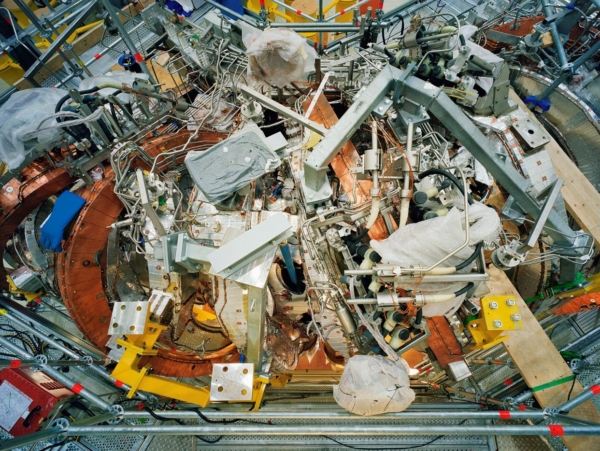
Another photograph will help develop this thought—Struth’s Stellarator Wendelstein 7-X Detail, Max Planck IPP, Greifswald 2009, a larger and in obvious respects far more complex and ambitious work. Again, an unreadable ensemble of hundreds (at least) of electronic and mechanical elements has been photographed at close range in the sharpest imaginable overall focus. Like the tokomak, the stellarator is a device for promoting nuclear fusion; as in the former, the plasma is contained in a magnetic field, where it is brought to tremendously high temperatures. According to Wikipedia, the Wendelstein 7-X is (or was) the most advanced of all stellarators, featuring a toroid (a kind of hollow twisted doughnut) with 70 superconducting magnetic coils, the whole thing roughly eleven feet high with a diameter of more than 50 feet. But what exactly are we looking at? A wide-angle view inside the stellarator? Notice in the first place that the image yields no sure sense of scale; at first, if my experience is typical, one has an impression of relatively modest dimensions, say six or seven feet across. But then one notices the lengths of metal (aluminum?) tubing at the bottom and the top left, as well as a certain diminution of scale in the uppermost tubes and the top of the photograph generally, and it begins to seem plausible that one is seeing a wide-angle view from above of a much larger compound piece of equipment. In any case, the viewer is subjected to vastly more multicolored information than they can readily process, a quantitative overmatching compounded by the fact that the ordinary viewer also lacks the technological knowledge that would enable them to identify the host of subsidiary devices which the image comprises or, a fortiori, to arrive at even the slightest understanding as to why such devices are juxtaposed with and connected to one another in precisely this manner. Not that the viewer doubts for a moment that everything in the photograph has been set in place in order to do its job. (The Shuttle photographs help secure that conviction from the start.) But even more, indeed far more than in the case of the tokamak photograph, the viewer’s conviction of overall technological purposiveness coexists with an almost complete inability to understand what they are looking at (what on earth is that three-, no, four-part angled element in the upper right quadrant of the image? or the four items surprisingly wrapped in translucent plastic? and why are they so wrapped?), as well as with a complementary sense of something like improvisation and arbitrariness in the relations among the various elements (the wrapping just mentioned seems nothing if not makeshift). Put the other way round, the dominant impression is not, or not simply, of extreme complexity—it is also, equally, one of contingency, irregularity, even a sort of creative chaos, as the innumerable elements for which one has no name nor the least grasp of function appear to have been fitted together any which way (so long as the fitting works), with the result that the total configuration lacks all sense of satisfying symmetry or even, except locally, visible order. And yet to come full circle (again, if my experience is typical), the viewer is drawn and held by a counter-impression of sheerest nested purposiveness from one margin of the photograph to the other.
At this point I want to make a suggestion that may seem to come out of the blue, but which in fact has been prepared by my descriptions of the tokomak and stellarator photographs—namely, that in certain crucial respects (the ones I have highlighted) Struth’s technology photographs invite being understood in relation to the philosopher Immanuel Kant’s account of the nature of aesthetic judgment, the judgment of the beautiful, in his magisterial Critique of the Power of Judgment (1790), the third of his great Critiques and arguably the most important treatise in all of philosophical aesthetics.11 As is well known, fundamental to Kant’s position is the claim that judgments of beauty are essentially subjective, grounded in feeling, which is to say that they are not based upon concepts (there are no arguments that can in effect compel someone to regard a particular work or object as beautiful), but that despite being grounded in feeling in this way judgments of the beautiful precisely make a claim of universality or universal validity. (It is not merely my personal view that a particular object or work is beautiful, rather my subjective experience somehow licenses the claim that everyone ought to agree with my judgment.) This is a difficult crux, to say the least, and philosophers down to the present are in disagreement as to what exactly Kant understood by such a claim and whether or not he can be taken to have succeeded in establishing its validity.
Fortunately this is not our problem in this essay. But Kant also made two related claims that are of immediate interest to us: First, that judgments of the beautiful do not presuppose an end or purpose—in German, Zweck—which the object is taken to satisfy. (This is related to the idea that their universality is not based on concepts or reasons.) Second, that such judgments “nonetheless involve the representation of what Kant calls ‘purposiveness’ [Zweckmässigkeit]. Because this representation of purposiveness does not involve the ascription of a purpose, Kant calls the purposiveness which is represented ‘merely formal purposiveness’ or ‘the form of purposiveness.’”12 (Famously summed up by the phrase “purposiveness without a purpose.”) And a related claim: that the unique kind of pleasure basic to judgments of the beautiful arises from what Kant calls the “free play” or “free harmony” of the faculties of imagination and understanding. In Hannah Ginsborg’s helpful summary in the Stanford Encyclopedia of Philosophy (from which I have been quoting):
In the Critique of Pure Reason, imagination is described as “synthesizing the manifold of intuition” [think of the latter as a mass of raw unstructured sensory data] under the governance of rules that are prescribed by the understanding….[Such rules] are, or correspond to, particular concepts which are applied to the object. For example, when a manifold is synthesized in accordance with the concepts green and square, the outcome is a perceptual experience in which the object is perceived as green and square. But now in the Critique of Judgment, Kant suggests that imagination and understanding can stand in a different kind of relationship, one in which imagination’s activity harmonizes with the understanding but without imagination’s being constrained or governed by understanding. In this relationship, imagination and understanding in effect do what is ordinarily involved in the bringing of objects under concepts, and hence in the perception of objects as having empirical features: but they do this without bringing the object under any concept in particular. So rather than perceiving the object as green or square, the subject whose faculties are in free play responds to it perceptually with a state of mind which is non-conceptual, and specifically a feeling of disinterested pleasure. It is this kind of pleasure which is the basis for a judgment of taste [of the beautiful].
The two points, purposiveness without purpose and the free play of the imagination and the understanding, are different aspects of the same basic notion. In Robert Pippin’s formulation:
The [first] is the “objective” dimension, the significance of the beautiful with respect to our understanding of our location in the world. The free play or harmony point is the “subjective” pole, how what would or could have been a conceptually regulated harmony of sensory material is occasioned without such a concept (i.e. without a concept of any purpose). That absence allows the distinctive harmony, that is, it allows the imagination free play but, somewhat miraculously, an ordered free play on its own; the intimation of purposiveness (without purpose) amounts to the significance of that experienced harmony.13
I hope the reader will excuse the seeming diversion into Kantian esthetics, but I also hope that they may already have begun to see why I believe that the diversion was called for by the tokomak and stellarator photographs. For consider: in the first place, I have been emphasizing the way in which both photographs leave the viewer in no doubt as to the overall, minutely calibrated purposiveness of the highly complex arrangements that they present to be seen while at the same time they totally defeat or deflect any possible understanding of what the overarching purpose or indeed the countless smaller nested purposes of those arrangements might be (and of course in both cases we are shown only part of the total device, how much or how little we have no idea). In other words, on the level of depiction, both images convey a sense of purposiveness without purpose. (Granted, we know, at least we do not doubt, that the real-world devices in question have an overarching purpose. But the photographs adamantly refuse to make that purpose accessible to us.)
And in the second place, I have been stressing the degree to which in both photographs the sense of purposiveness coexists with a strong impression of contingency, arbitrariness, improvisation—a sort of free play of elements and connections which somewhat miraculously (as Pippin says) produces a sense of harmony and order, which is to say of mutual attunement among the elements and connections, and also in a sense between the image and the viewer, the ultimate basis of which we can only faintly intuit. (As Kant remarks early in the Third Critique, “The representation is related entirely to the subject, indeed to its feeling of life, under the name of the feeling of pleasure or displeasure, which grounds an entirely special faculty for discriminating and judging that contributes nothing to cognition but only holds the given representation in the subject up to the entire faculty of representation, of which the mind becomes conscious in the feeling of its state.” [CPJ, 90]. A mouthful, but the meaning is clear.) Seen in this light, the tangles of wires and tubing in the tokamak photograph epitomize the “subjective” pole of such free play, as does the more embracing evocation of near-chaos in the stellarator image—so I want to suggest. What all this amounts to is the proposal that Struth’s technological photographs, or at least the tokomak and stellarator images (with certain others to come), may be seen virtually as allegories or, perhaps better, as actualizations—“objective correlatives,” to use an Eliotic term in a context he could not have imagined—of the Kantian judgment of the beautiful, which is not exactly the same as saying that they are beautiful on a Kantian interpretation of the concept. But understanding the photographs in these terms helps account for their very considerable sensuous-intellectual allure, which even at first encounter seems disproportionate to the theme of technology as such. (My impression is that I am by no means the only viewer to so respond to them.14 ) Let me add that seeing the photographs in this way militates against the idea that they “confront forms of a negative technological sublime,” a formulation first put forward by Benjamin H.D. Buchloh.15
To which it should be added that for Kant theorizing the beautiful, the purposiveness at issue is pleasant in some sense or other because it is nature’s purposiveness, and in the judgment of the beautiful we experience a kind of reassuring “fit” between our moral or “supersensible” vocation and nature itself—a large and subtle matter which goes beyond the scope of this essay. (Hence the sense of attunement between photograph and viewer mentioned a moment ago.) Kant of course has nothing to say about technology—he is too early for that—but it seems fair to speculate that for him nature versus technology would be a huge dichotomy, which makes it all the more significant that the photographs we have been discussing intimate a Kantian pleasure in a mode of free play which they occasion precisely in the presence of the latter. The link with the Paradise pictures also seems deliberately to call the technology photographs’ breathtaking complexity to mind as on a par with—contrary to any dichotomy—nature itself. On this basis alone, the tokamak and stellarator photographs are indeed works of the highest fascination.16
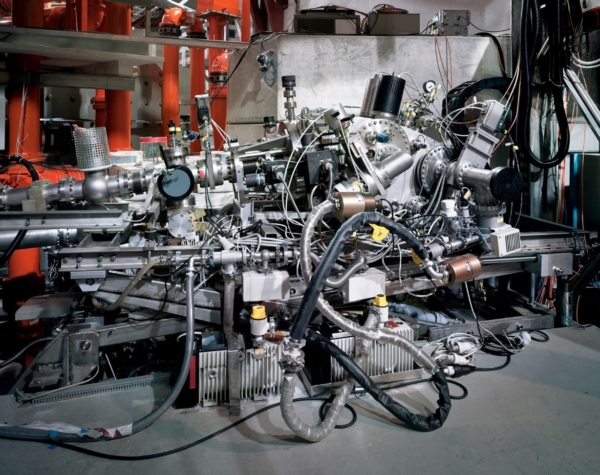
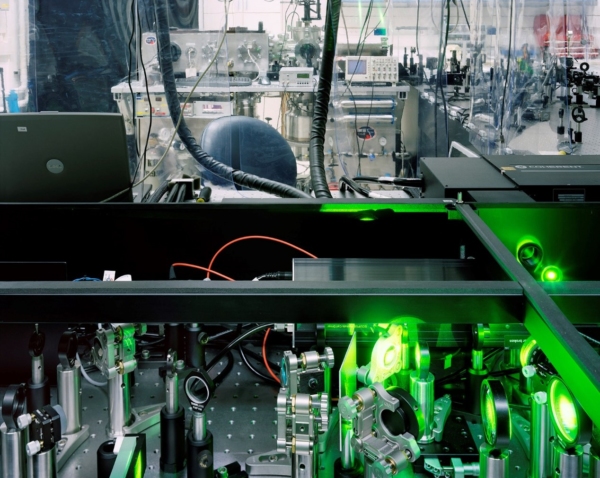
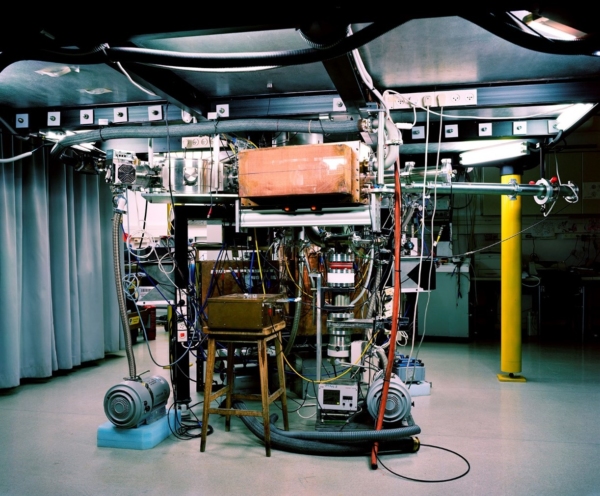
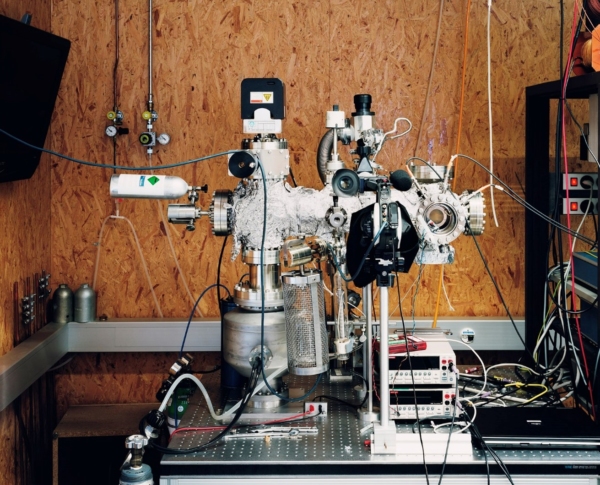
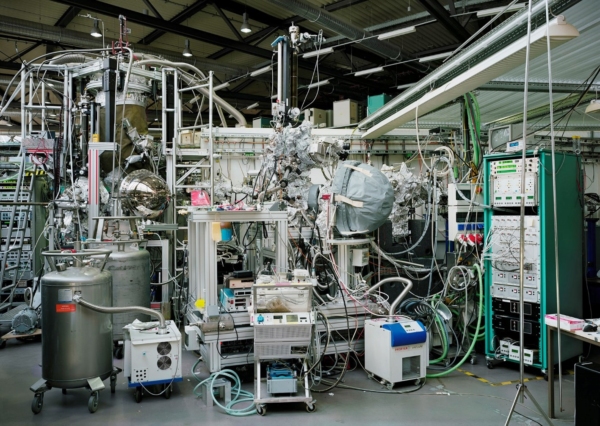
Five more photographs might be glanced at in this connection: Grazing Incidence Spectrometer, Max Planck IPP, Garching, Germany, 2010, High Harmonic Generation Spectrometer, Weizmann Institute, Rehovot 2009 (the lurid green not having been added by Struth), Z-Pinch Plasma Lab, Weizmann Institute, Rehovot 2011, Field Ion Microscope, University of Zurich 2010, and Measuring, Helmholtz-Zentrum, Berlin 2012. The third of these, Z-Pinch Plasma Lab, has the slackest set of wire connections we have yet observed, while the fourth, being a microscope but unrecognizable as such to the uninformed (i.e., to us), underscores the degree to which the devices photographed by Struth are devoid of the least hint of anthropomorphism. The last, Measuring, with its depiction of separate floor units having been brought loosely together into a single incomprehensible configuration, carries the motif of improvisation or indeed assemblage to a new extreme.
3
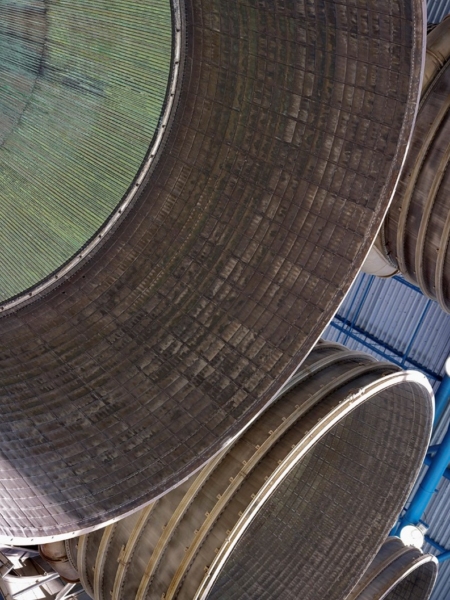
At this point, I want to shift gears (not really, as will become clear) and look at a number of other photographs that will introduce a different but related theme—that of the formal organization of the photographs themselves. Let me start with an early image, Saturn V Engine, Kennedy Space Center, Cape Canaveral 2008, a view of three of the Saturn V’s five Rocketdyne F-1 engines, seen in angled perspective from relatively near to relatively far, all three severely cropped by the edges of the print. (In fact we glimpse a bit of a fourth engine at the upper right.) As is at once clear, this image differs radically from those we have been looking at owing to its much greater simplicity and the absence of any multiplicity of elements; instead it rather dramatically juxtaposes the engines with their sweeping curves with the straight-edge, rectilinear limits of the photograph to powerful effect.
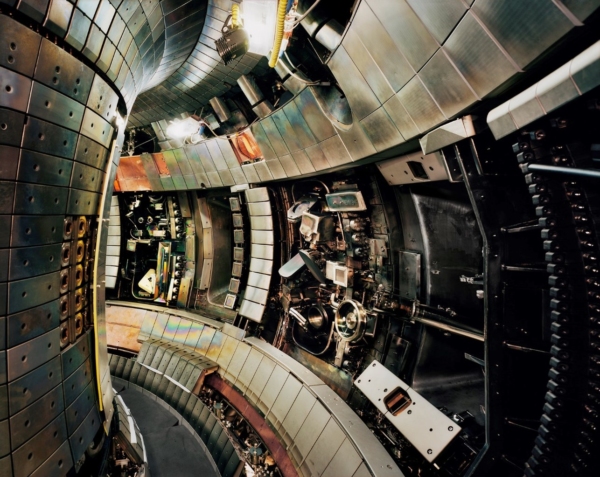
No other technology photograph is quite like this one.17 But consider, for example, Tokamak Asdex Upgrade Interior 1, Max Planck IPP, Garching 2010, which depicts a large and elegant device—presumably the tokamak itself—circular in basic form (or say footprint) and with gleaming metallic concave walls, set in a round room or chamber of unreadable dimensions. The chamber in turn has concave walls, inset with gleaming metal plates similar to those on the central form and also inset with a host of sophisticated-seeming devices all no doubt having to do with controlling the fusion processes in the tokamak itself.
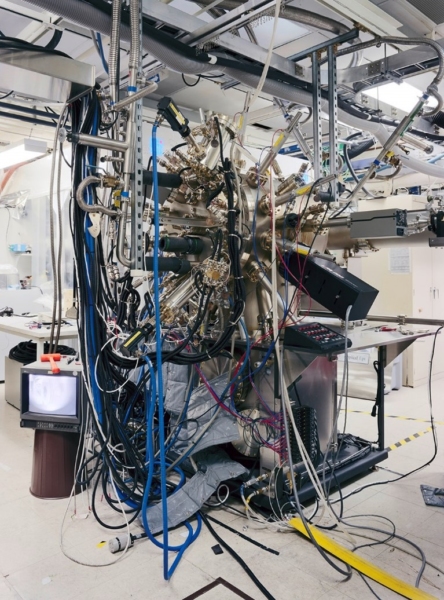
Or, moving ahead in time, there is Epitaxy, JPL, Pasadena 2014, a device or part of a device for “depositing a crystalline overlayer on a crystalline substrate” (Wikipedia again), so as to produce extremely refined detector arrays for large telescopes and the like (“JPL” being the Jet Propulsion Laboratory at Cal Tech). (Needless to say, I can’t guarantee the rightness of my explanation.) Once again, there is a strong impression of bricolage, with numerous largely slack wires in blue, black, gray, and red and only the most minimal or intermittent sense of a rigid supporting architecture, much of what there is coming down from above. Notice, in this connection, the TV-like unit at the lower left, with an orange hammer lying on top of it; and notice, too, what seems a kind of inverted waste-paper can underneath the unit and supporting it—can this be right? And is the unit part of the larger assemblage or not? In other words, the epitaxy itself has much in common with the “free play” aspect of the tokamak and stellarator photographs. But more than in either of those images there is also a definite sense of concavity, largely owing to the fall of the thick blue and black wires at the left and the light gray wires to the right, so that here too, as in the Tokamak Asdex Interior 1, the viewer instinctively contrasts the disposition of the device (upright but internally slack and curving) with the rectilinearity of the enclosing image-shape (itself affirmed, as is not the case in the tokomak photograph, by architectural elements chiefly in the upper region of the image).
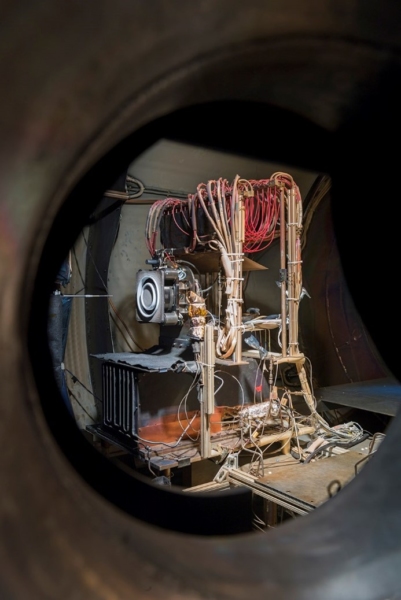
To confirm the point—to bring out as strongly as possible Struth’s emerging stake in the juxtaposition of round versus straight (at a bare minimum)—we might look at Hall Thruster, JPL, Pasadena 2013, a propulsion device for space travel. Wikipedia: “Hall-effect thrusters trap electrons in a magnetic field and then use the electrons to ionize propellant, efficiently accelerate the ions to produce thrust, and neutralize the ions in the plume.” None of this can be gleaned from the photograph, of course—in that sense it remains consistent with the purposiveness without purpose theme I have been stressing—and we should note too the slackness of the orange wires and the improvisational feel of the way in which various lengths of tubing (as it seems) have been tied to upright elements that provide a kind of minimal architecture for the device as a whole (or as much of the device as we are shown). But what is even more striking is the fact that the photograph appears to have been taken through some kind of oculus, with the result that the curved-versus-straight theme is here made perfectly explicit, and in a way that redounds back on the character of the central image itself (we belatedly take in the juxtaposition of the curving wires with the minimal architecture).
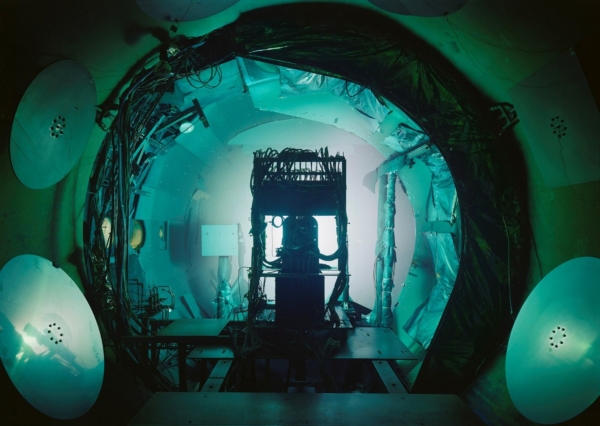
Or, as if deliberately going further with the same basic compositional structure, there is Vacuum Chamber, JPL, Pasadena 2013, in which the central device or piece of equipment, shown mainly in silhouette, is framed by a large oculus-like opening which itself has a double character—a dark ringlike form “this” side of the opening (mainly evident to the right, where it appears sheathed in dark plastic) and a second oculus beyond that, which seems to be largely wrapped in light blue plastic. Plus there are four round forms with small central perforations to the right and left of the main opening, the two at the bottom sharply cropped by the framing edge, further underscoring the round-versus-straight idea.
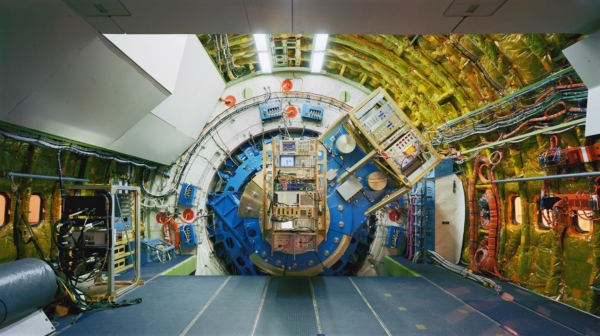
Finally, there is GREAT, Armstrong Hangar 703, Palmdale 2014, a large spaceship-interior-like structure the function of which eludes me (Wikipedia is no help) but which exemplifies, on a very large scale, both the purposiveness without purpose and free play themes that I have associated with the technology photographs generally and the round-versus-straight motif that, starting with the photograph of the Saturn V engine, I have been bringing to the fore. I regard it is self-evident that the latter compositional motif can only be deliberate on Struth’s part, and can only have for its aim the imposing of a definite formal structure on the images in question—as if (but really there is no “as if” about it) he is seeking to supplement the absence of (intelligible, specifiable) overall purposiveness that marks so many of the technology photographs with a conspicuous (because contrastive) overall purposiveness of his own, a purposiveness (or intendedness, to hark back to an earlier term) that governs not the contents of the image (which of course are beyond his power to influence) but the nature, the structure, of the image itself.
It follows that the photographs in question—the last five I have discussed—are doubly Kantian: by virtue both of their analogy with the judgment of the beautiful and of their ultimate reliance on a concept of form that is perhaps Kant’s most conventional, eighteenth-century piece of theorizing in the Third Critique. The somewhat notorious passage reads: “In painting and sculpture, indeed in all the pictorial arts . . . the drawing is what is essential, in which what constitutes the ground of all arrangements for taste [i.e. the judgment of the beautiful] is not what gratifies in sensation but merely [i.e. strictly] what pleases through its form. The colors that illuminate the outline belong to charm [i.e. not beauty]; they can of course enliven the object in itself for sensation but they cannot make it worthy of being intuited and beautiful . . .” (CPJ 110). Needless to say, my characterization of these remarks as conventional does not imply a criticism of Struth’s photographs in which the curved-versus-straight compositional structure is manifestly in force. Not only did his images, being works of art-in-the-making, require to be framed in some decisive way (i.e., one that declares their pursuit of strong aesthetic autonomy). It is also the case that the curved-versus-straight “solution” turns out to be far more effective, at least to my eye, than when Struth opts for a more conventional match between a rectilinear internal structure and the rectilinear limits of the photograph (see e.g. Pharmaceutical Packaging, Laboratories Phoenix, Buenos Aires 2009 and Distillation Column, Gladbeck 2009). But framing as such inevitably belongs to what Kant in the passage just cited calls drawing, with the consequence that the deeper internal structure of the technology photographs as a group makes their partial reliance on a merely formal notion of form (if I may so put it) stand out more strongly than might otherwise be the case.
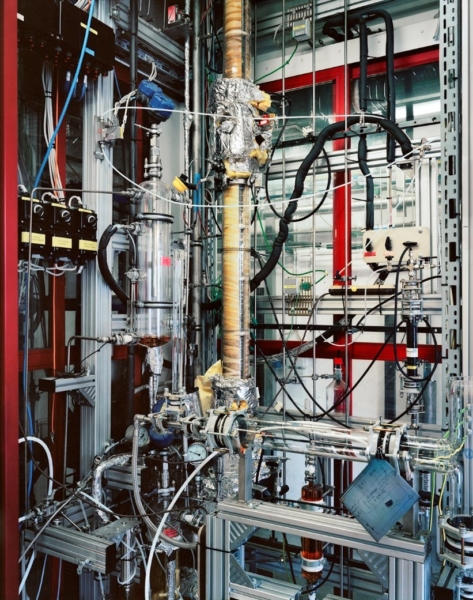
4
Finally, a word about the implication of the technology photographs for thinking about sculpture. It is Struth himself who suggests the relevance of doing so when he writes that he has sought “to open the doors to what our minds have materialized and transformed into sculpture and to scrutinize what our contemporary world creates in places which are not accessible to most people.”18 This is a tremendously interesting remark, which to the best of my knowledge Struth has never followed up, and my thought is that it is most usefully pursued in connection with the dialogue I have already evoked between the technology photographs and the brilliant and resourceful oeuvre of Thomas Demand. As was mentioned earlier, Demand began as a sculptor making works in paper and cardboard and turned to photography when it became clear to him that the models themselves lacked something vital—a kind of definiteness and specificity with regard to distance from the motif, point of view, lighting, and even color—which photography then very effectively conferred on them. (Cf. Baudelaire’s argument in his Salon of 1846 that, compared to the “despotic” character of painting which imposed a single point of view on the beholder, sculpture in its three-dimensionality was “vague” and “ambiguous,” hence unable to establish itself as art with requisite force. Demand’s photographs amount to an inspired response to such criticism, not that they were intended in that light.19 ) For Demand, as we have seen, the gain in definiteness is in the interest of the thematization of intendedness or purposiveness, in my account his basic concern—one that I have suggested had a certain precedent in Struth’s black-and-white cityscapes and a sequel precisely in the technology photographs.
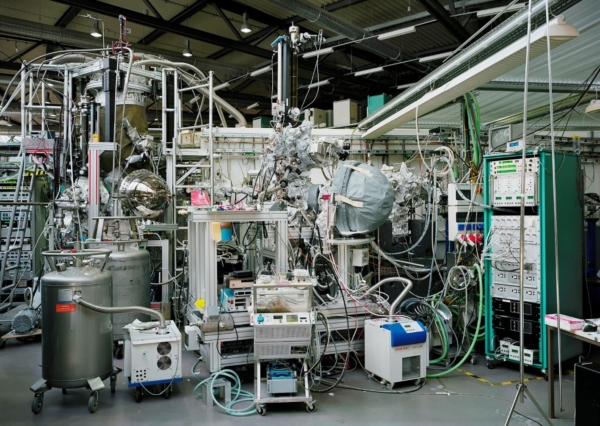
The comparison with Demand has two further implications: First, although Struth does not say as much, I take his remark about what “our minds have materialized and transformed into sculpture” to apply less to the devices he photographs, though that may indeed be what he meant, than to the devices-as-they-appear-in-his-photographs, where in addition to a Demand-like definiteness as regards point of view, lighting, and color, they are marked by an ocular precision, keyed to an incommensurable fineness of detail, that simply in themselves—as objects in the world, encountered by human subjects operating under the normal conditions of ordinary shifting-focus binocular vision—they would surely lack. (A version of Baudelaire’s point, made more general.) This is particularly impressive, I think, in the case of Measuring. Helmholtz-Zentrum. Berlin 2012, generically less a sculpture than some sort of assemblage (as my earlier description of it suggested). I have never been a fan of assemblages as works of art, and my sense is that had I encountered the original congeries of devices on a visit to the Helmholtz-Zentrum, assuming such a visit to have been feasible, it might have snagged my attention for a moment but would not have stopped me in my tracks and compelled me to contemplate it for any length of time. As photographed by Struth, however, the loose but collectively purposive gathering of elements with its snaking tubes, seemingly tangled wires, and portions wrapped in crinkled aluminum foil (see the upper middle and to the right, beyond the sideways rounded form in a light blue “hood”) turns out to be hypnotically arresting, a state of mind that finds its own image, so to speak, in the gleaming convex metal element which is suspended roughly halfway up in the left-hand half of the photograph and which reflects in distorted form a portion of the room in which the photographer is at work. (A stunning photographic detail in the catalogue shows that the latter point was not lost upon Struth.) There is in all this a larger question as to the relationship between sculpture and photography in the present state of the two arts which there is no time to pursue.20
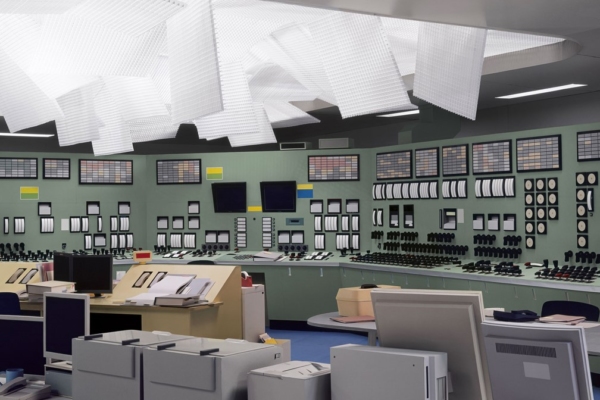
A second implication of the comparison with Demand is that Struth’s “use” of actual devices rather than cardboard models of places and things makes possible the eliciting in the viewer of a sense of mysteriousness or even awe about the devices’ own mode of being, a feeling that Demand’s subtractive procedures rule out from the start. (A certain ghostliness or emptiness, a sense of the uncanny, marks Demand’s production, as others have observed; this is not a criticism, merely a characterization of the Stimmung of his marvelously original photographs.) Interestingly, actual persons have no place in either body of work, in Demand’s case by its very nature, in Struth’s, with a very few exceptions, one of which is the picture of the Shuttle under repair, because they would distract from the relentless focus on the technology itself. Indeed it is hard to imagine Demand modelling any of the devices in Struth’s photographs (the models, one feels, would have to be constructed with exactly the same components as the devices), though as mentioned earlier Struth’s image of a NASA control panel almost certainly is a nod to Demand’s Poll—and a subsequent Demand photograph, Control Room (2011), based on the Fukushima disaster, could simply as regards their respective dates be seen as going on from the Struth. In sum, it is as if Struth, in the most characteristic and, to my mind, the most vivid and compelling of the technology photographs, such as those treated in this essay, deliberately chose subject matter that Demand could not have engaged with—though it goes too far to suggest that Struth was actually thinking along these lines. But of course that only makes the dialectical relation between their respective oeuvres all the more intriguing to contemplate.
5
A postscript (2020). In a brief section called “On the Ideal of Beauty” Kant distinguishes between the normal idea of the beautiful, defined as “the image for the whole species, hovering among all the particularly and variously diverging intuitions of the individuals, which nature used as the archetype underlying the productions in the same species, but does not seem to have fully achieved in any individual,” and the ideal of the beautiful, “which…can be expected only in the human figure.” He continues:
In the latter the ideal consists in the expression of the moral, without which the object would not please universally and moreover positively (not merely negatively in an academically correct presentation). [Negatively in the sense of avoiding individual particulars.] The visible expression of moral ideas, which inwardly govern human beings, can of course be drawn only from experience, but as it were to make visible in bodily manifestation (as the effect of what is inward) their combination with everything that our understanding connects with the morally good in the idea of the highest purposiveness . . . The correctness of such an ideal of beauty is proved by the fact that no sensory charm is allowed to be mixed into the satisfaction in its object, while it nevertheless allows a great interest to be taken in it, which then proves that judging in accordance with such a standard can never be purely aesthetic, and judging in accordance with an ideal of beauty is no mere judgment of taste. (CPJ, 119-20)
Not surprisingly, Kant, not being Hegel, gives no example of such an ideal in actual art, but perhaps his remarks (a slight qualification of the generality of his basic theory) provide a basis for introducing two arresting photographs by Struth that in effect bring the technological series in Nature and Politics to a close, Figure, Charité, Berlin 2012 and Figure II, Charité, Berlin 2013. The first is of a prostate operation conducted by a “Da Vinci remote surgery machine,” the second of a moment before a technology-assisted brain tumor operation, with the patient under anesthesia—in Struth’s words “a dramatic moment, an expression of hope in and surrender to technology and its use through the human hand and mind.”21 In neither, of course, is the human figure visible as such; nor is either aesthetically compelling in the vein of the photographs considered in this essay. But both photographs, it might be argued, invoke under the sign of technology “the morally good in the idea of the highest purposiveness”—no mere judgment of taste but of value nevertheless.22
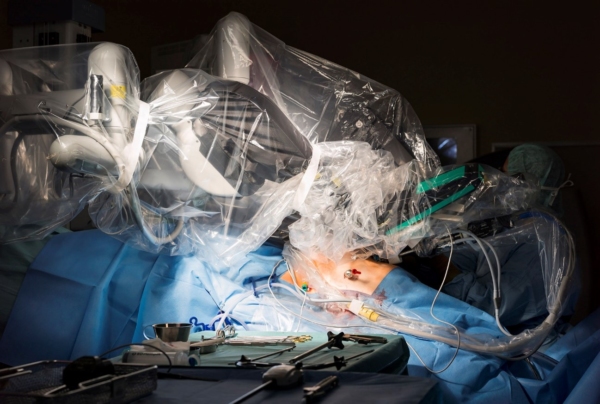
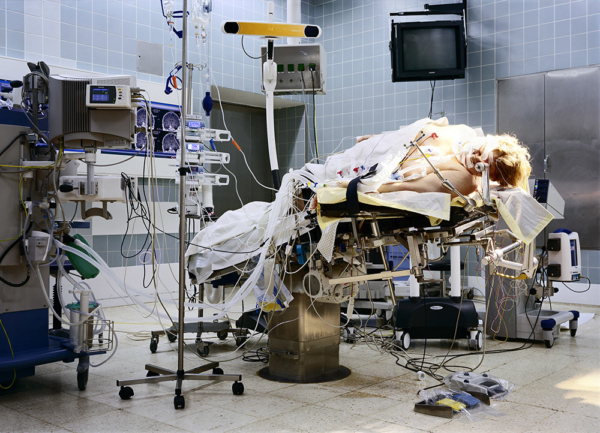
Notes
Struth’s most recent work not only expands on that experience of photography’s confrontation with spectacle’s incommensurability, but it actually confronts forms of a negative technological sublime, attempting to construct photographic records of realities no longer defined by structural transparence and functional evidence. These are structures of everyday life that are for the most part hidden from public access and view, whose technological complexity is unimaginable . . . Struth’s new photographs [thus] record structures that are intellectually incomprehensible to the majority of spectators when they are facing these advanced technologies. By confronting their technological incommensurability with the seemingly endless curiosity of the photographic eye, these images suddenly seem to contest the credibility of the photographic image, or to challenge the continuing functions of photography itself. Thus a dialectical tension emerges within the photograph itself, since it seems to acknowledge photography’s historical boundaries when reaching the new technological incommensurability, and it formulates photographically its own failure to provide any longer the systems of denotative referents and an empirical verifiablity of phenomena selected from the purview of what used to be defined as the real. (n.p.)↑
1
Between 2008 and 2015 the contemporary photographer Thomas Struth made a number of large color photographs of technological and scientific subjects, twenty-five of which (or more, depending on how one counts) were included in the exhibition titled Nature and Politics that for two years (2016-18) traveled among museums in Essen, Berlin, Atlanta, and St. Louis. (There is a comprehensive catalog with excellent illustrations of all the photographs.)1 Struth refers to them as his “technology” photographs, and I shall follow him in this. I’m not sure exactly when I saw a few of them for the first time, but from the start I found them compelling, and over the years, in galleries in this country and abroad, I watched the series ramify and develop. What I want to do in this essay is look closely at a number of the technology photographs in an effort to explain exactly what it is that makes them singularly gripping (to me, anyway) at the present moment (time of writing: summer 2016) in the evolution of the contemporary “visual” arts.2

Let me begin by glancing at one of the first in the series, Space Shuttle 2. Kennedy Space Center, Cape Canaveral 2008. Right off, it calls to mind a large and impressive photograph by the Canadian photographer Jeff Wall, Restoration (1993), which depicts youthful restorers at work on the so-called Bourbaki Panorama in Lucerne. (The 360-degree panorama by Edouard Castres depicts a scene from the Franco-Prussian War, the arrival in Switzerland of the starving and exhausted remnants of the French Army of the East led by General Charles-Denis Bourbaki.) The two photographs differ in format, Wall’s being quasi-panoramic in its own right, but the basic idea of depicting a woman restorer on an elevated platform has much in common with Struth’s composition of fifteen years later. I have to assume that Struth was aware of this and at the very least was willing to accept the comparison.3 As we shall see, Struth’s technology photos are in implicit dialogue both with earlier series in his own oeuvre and with the work of other photographers, not just Wall but also, especially, Struth’s younger contemporary, Thomas Demand.
For me the deeper interest of Struth’s photograph is thematic: the upper half of the composition is dominated by the under-surface of the Space Shuttle with its diagonal grid of heat-defying ceramic tiles; the implication is that the young woman in the left foreground and perhaps also the two men farther back and to the right are working on these. That they are doing so is nothing less than a matter of life and death. That is, it is absolutely crucial to the success of the Shuttle’s missions and the survival of the astronauts inside it that the tiles resist the formidable heat of reentry and even more that they do not come loose from the surface of the Shuttle. This may seem to go without saying, and in a sense it does, but taking this photograph as thematic for the series as a whole (as its position early in the exhibition catalogue encourages one to do), it also suggests that there will be no tendency in the series to shift the implied locus of agency away from human beings to the technology itself—a point driven home by the fact that this is the only one of the technology photographs to include human agents. And this means that the technology photographs will have nothing whatever to do with any so-called “vital materialism” such as that espoused by political scientist Jane Bennett and other theorists of her inclination, which would seek to minimize the role of human agents in any consideration of human/technological interaction in the direction of the so-called vital capacities of the technology as such.4 Thus Bennett supports Bruno Latour’s notion of “distributive agency,” a feature of his so-called “Actor-Network theory,” according to which Latour “strategically elides what is commonly taken as distinctive or even unique about humans” (ix). As she also remarks, she wants to highlight “the agentic contributions of nonhuman forces . . . in an attempt to counter the narcissistic reflex of human action and thought” (xvi). (By which she means she wants to counter the basic distinction between animate subjects and inanimate matter. All this she imagines as ultimately a political project designed to include material objects in a larger conception of the polis.) I find such arguments unpersuasive, not to say absurd, but they have found traction in various precincts of the academy in the United States and abroad, and it seems important to put them out of play from the start. More precisely, I take Struth’s Space Shuttle 2 as performing such an operation—as establishing certain basic parameters for coming to terms with the photographs that follow. This would be one implication of his allusion, if that is what it is, to Wall’s Restoration, another image of human beings repairing a material artifact.

It is not surprising, therefore, that the very next photograph in the catalogue, Control Panel, Kennedy Space Center, Cape Canaveral 2008, makes a point of the same issue of agentic control by showing us three lateral rows of individual control panels, all bearing evidence of their absent human occupants (looseleaf binders, binoculars, earphones, etc.), with chairs bearing on their backs lightweight jackets with the designations “IBM,” “McDonnell Douglas,” and “Boeing”—but with no humans in sight (the rule from here on out). Yet there is not the slightest implication that the control panels are capable of operating on their own. Indeed it is as though Struth is deliberately emphasizing the issue of control in these early photographs, by way of clearing the ground interpretively for what will follow.

And something else: Control Panel, Kennedy Space Center may be seen as alluding to a well-known earlier photograph by Thomas Demand, Poll (2001), which was based on media images of the Emergency Operations Center in West Palm Beach, Florida, where in November 2000 election authorities went through tens of thousands of ballots in an attempt to determine whether Albert Gore or George W. Bush had won the state and hence the national election. (Eventually, of course, the count was halted by a decision of the Supreme Court and the election handed to Bush.) As by now is widely known, Demand’s photographs begin by reproducing in paper and cardboard, most often at full scale, a scene, place, or situation known from media images and then photographing with a view camera the model that results. (Demand began as a sculptor and thinks of the models as sculptures of a sort, given definitive form by the photographs of them; this will be of further interest to us.) Invariably, the paper and cardboard models are at once meticulously made and visibly flawed, lacking important details (in Poll all the ballots and post-its are blank, the telephones lack numbers on their faces, and there is no room for seats between the curving rows of desktops), so as to leave the viewer in no doubt as to what he or she is looking at—a photograph of a model rather than of an original scene. The question that must then be asked is why Demand chooses to proceed in this extremely labor-intensive way, and my answer, first put forward in my book Why Photography Matters as Art as Never Before (2008), is that by so doing he is able to accomplish two complementary purposes: first, to present images of places and objects that have been rigorously purged of every causal trace pertaining to the original situation; and second, to replace those traces with marks and indices of his own process of making, which is to say “to replace one or more mediatic images of [a particular place or situation] with a counter-image of sheer artistic intention, as though the very bizarreness of the fact that the places and objects in the photographs, despite their initial appearance of quotidian ‘reality,’ have all been constructed by the artist throws into conceptual relief the determining force…of the intentions behind them.”6 (More on that too further on.) Seen in this light, Poll is virtually an allegory of Demand’s basic project, in that what took place in the Emergency Operations Center was a days-long attempt to determine the intentions of a substantial number of Florida’s voters, whereas the photograph makes visible—it exists to make visible—no intentions other than the artist’s own. More broadly, Demand’s photographs invite being understood as thematizing intendedness as such, an aim that locates them at the farthest pole from the emphasis on indeterminacy—the idea that the meaning of a work is nothing other than each viewer’s subjective experience of it—that has been a staple of postmodernism from the very start. (A large topic, needless to say, from which I will draw back. My profound disagreement with the indeterminacy position goes back to the critique of minimalism/literalism in my 1967 essay “Art and Objecthood” and indeed earlier.)7
Shortly it will become clear why the digression on Demand was necessary. At the very least, though, we can say that Struth’s Control Panel stands in a kind of dialectical relation to Demand’s Poll by virtue of supplying the sorts of real-life details that the earlier work systematically elided.
2

We come now to one of the first technology photos that initially caught my attention, Tokamak Asdex Upgrade Periphery, Max Planck IPP, Garching 2009. Garching is a recently created city near Munich, and a tokamak is a device for producing nuclear fusion by containing the super-heated plasma (the fourth fundamental state of matter after solids, liquids, and gases) based on heavy hydrogen (i.e., the isotopes deuterium and tritium) within a powerful magnetic field. Obviously the photograph shows us only a portion—presumably a small portion—of the entire device; equally obviously, Struth cannot have expected his viewer to know even approximately what they were looking at, or even, having read the title, to know what a tokamak is. (My knowledge, needless to say, has been gleaned from Wikipedia.) What the viewer does understand, however, is that they are in the presence of a photograph of an extraordinarily complex piece of equipment, one comprising an uncountable number of tubes and wires as well as a host of subsidiary devices, with none of which the viewer is familiar, all assembled and connected with one another in immeasurably complex ways. Put slightly differently, the viewer realizes at once that what they have been given to see goes far beyond their power to take it in, no matter how long or with what effort of scrutiny they give themselves over to the image.

In this regard the technology photographs—taking Tokamak Asdex Upgrade Periphery as characteristic of them as a group (or at least of a subgroup that particularly interests me)—bear a close relation to an earlier series by Struth, his Paradise photographs (1995-2008), in which, as he put it in an interview with an art critic for the British newspaper The Guardian, “everything was so complex and detailed that you could look at them forever and never see everything.”8 (We are looking at Paradise 28 [2005].) As he earlier remarked, the Paradise photographs “contain a wealth of delicately branched information, which makes it almost impossible, especially in large formats, to isolate single forms. One can spend a lot of time in front of these pictures and remain helpless before them.”9 For Struth, the further import of those photographs is “spiritual”—as I wrote in Why Photography Matters, “the pictures in his view ‘emphasize the self’ and provide occasions for meditation and internal dialogue” (WPM, 300). But I also suggest that the viewer is in effect distanced and excluded by such imagery, as if Struth in that series were seeking to go against his own natural impulses by bringing about “a different, resolutely non-empathic relation between picture and viewer” (WPM, 299).
If we now return to a consideration of Tokamak Asdex Upgrade Periphery, several points begin to emerge. As some have noted, it and other photographs like it are characterized by a degree of internal complexity comparable to that of the Paradise photographs. But there are crucial differences between the two series. For one thing, whereas in the Paradise pictures the foliage in a variety of greens creates a dense screen that effectively resists our acts of seeing, a photograph such as the one we are looking at—close-up, high-definition, seemingly brightly lit—positively attracts the gaze even as it offers the latter far more information than can be effectively processed. So it wouldn’t be true to say that the proliferation of elements makes it almost impossible to isolate single forms. Rather, we are offered a profuse tangle of such forms, especially metal tubes and wires, the latter differentiated in part by bright color—blue, red, white—which one takes to be veridical. (According to Struth, the photographs are “basically straight.” A number of them are digital, with no negatives. In a few instances he combined two negatives to create a more panoramic picture ratio. In any case, color plays an essential role throughout the series—it is impossible to imagine any of the photographs succeeding aesthetically in black-and-white.)10 Or take the thicker dangling length of tubing at the upper right, or the lengths of piping below it, or the thicker tube at the very top of the picture, left of center—to say nothing of the numerous smaller, subsidiary devices, especially toward the upper left and lower left and center of the picture. In other words, there is a fundamental difference between the naturally teeming, monochromatic (i.e. green), undifferentiated content of many of the Paradise pictures and the entirely man-made, constructed content of the technology photographs. This seems obvious, but the further import of that difference calls for spelling out. Here one comes to the interpretive core of the technology photographs as I understand them.
What I mean is the following: the technology photographs appear full of—in effect charged with—the evidence of human intentions. That is, we do not doubt for a moment that every wire, every length of tubing, every switch, diode, transistor, condenser, resistor, amplifier, oscillator, and voltage regulator (to name various pieces of electronic equipment on the supposition that some at least of these are in play in various of the photographs), in short every electronic device and accessory however small and inconspicuous, was positioned where it is shown to be by a human agent or a team of human agents so as to bring about a nested series of specific outcomes. At the same time, equally crucial to my account, no matter how hard or closely or committedly one looks one is absolutely unable to grasp either the larger, overarching purpose of the tokamak itself (only part of which is shown; how large a part? we have no idea) or for that matter the lesser, partial purposes of the individual devices and their connections. Indeed my further suggestion is that precisely this double state of affairs—the evocation of an unexampled density of intentional, purposive traces or indices that on the one hand compels the viewer’s close, not to say strained attention and on the other defeats from the start the viewer’s best efforts to make sense of what they have been given to see—is a major source, if not the major source, of the fascination that many persons have reported experiencing in the face of the technology photographs.
In itself this is extremely interesting, not least because it forms a link with Thomas Demand’s oeuvre by way of the latter’s systematic thematization of authorial intention as I have presented it. In fact, there is also a link with a famous series in Struth’s own previous production, his greatly admired black-and-white cityscapes from the 1980s, which in Why Photography Matters I gloss as virtual palimpsests of traces of intentions as expressed in urban architecture and its historical vicissitudes. (For example, Düsselstrasse, Düsseldorf [1979].) As I there put it: “The places in Struth’s [city] photographs typically represent the collaging together of traces of multiple intentions, traces laid down at different, even widely disparate moments, thereby modifying, covering, or effacing the traces of previous intentions, so that the scene as a whole presents itself as everywhere stamped by intention albeit…not by a single or a collective intention to produce the scene, the place, the milieu as it appears to the viewer” (WPM, 277). In this connection I quote the twentieth-century German writer Robert Musil: “[The individual] is formed by the back-formations of what he has created. If one takes away those back-formations, what remains is something indefinite, unshaped. The walls of the street radiate ideologies” (WPM, 281). I might add that black-and-white with subtly differentiated greys is as instrumental to the success of the cityscapes as color is to that of the technology photographs. I also suggest that Struth’s cityscapes “were a crucial element in the artistic and intellectual context within which Demand’s almost exactly antithetical initiative…took shape” (WPM, 281). In other words, with Struth’s technology series we apprehend a three-stage relation between Struth’s black-and-white cityscapes, Demand’s photographs of his ingenious paper reconstructions, and the technology photographs themselves, all keyed to the primacy of intention, each stage in the dialogue or dialectic implicitly alluding to the one or ones before.
But we are not done with Tokamak Asdex Upgrade Periphery and its thematizing of intention. For what also strikes me (with ever greater force on repeated viewings) is the blend it offers of what I have called density of intentional indices with the simultaneous assertion of something very like contingency. By contingency I’m referring above all to the general sense of tangle and confusion that issues from the bunches of fine colored wires at the heart of the image, or the various loops and semi-loops formed by lengths of somewhat thicker gray wire or tubing as if in counterpoint to the thinner ones, or the hanging semi-loop of thicker tubing at the upper right, and more broadly to the overall looseness or slackness, the (to me surprising) non-rigidity, of the bulk of the elements which the image comprises. More precisely, it seems clear—one assumes without thinking—that each of the many wires connects two or more points that need to be connected in order that the larger device, the tokamak as a whole, operate as it is meant to do. And it seems equally clear that the precise configuration of wires and such—the various curving or looping paths they follow—were not specifically intended by the tokamak’s designer or maker or team of designers or makers to be precisely or even approximately as we find them. (The exact configuration, we might say, was a matter of artifactual indifference so long as it allowed the required connections to be made.) In other words, the tokamak photograph brings together in a single dense, complex, internally multifarious image a sense of absolute purposiveness—this must connect with that or the device will fail (not that for the most part we are plainly shown the connection points, the “this” or the “that,” but we assume they exist)—and a sense not quite of arbitrariness but of very considerable flexibility with regard to everything that lies outside the realm of strict technological necessity.

Another photograph will help develop this thought—Struth’s Stellarator Wendelstein 7-X Detail, Max Planck IPP, Greifswald 2009, a larger and in obvious respects far more complex and ambitious work. Again, an unreadable ensemble of hundreds (at least) of electronic and mechanical elements has been photographed at close range in the sharpest imaginable overall focus. Like the tokomak, the stellarator is a device for promoting nuclear fusion; as in the former, the plasma is contained in a magnetic field, where it is brought to tremendously high temperatures. According to Wikipedia, the Wendelstein 7-X is (or was) the most advanced of all stellarators, featuring a toroid (a kind of hollow twisted doughnut) with 70 superconducting magnetic coils, the whole thing roughly eleven feet high with a diameter of more than 50 feet. But what exactly are we looking at? A wide-angle view inside the stellarator? Notice in the first place that the image yields no sure sense of scale; at first, if my experience is typical, one has an impression of relatively modest dimensions, say six or seven feet across. But then one notices the lengths of metal (aluminum?) tubing at the bottom and the top left, as well as a certain diminution of scale in the uppermost tubes and the top of the photograph generally, and it begins to seem plausible that one is seeing a wide-angle view from above of a much larger compound piece of equipment. In any case, the viewer is subjected to vastly more multicolored information than they can readily process, a quantitative overmatching compounded by the fact that the ordinary viewer also lacks the technological knowledge that would enable them to identify the host of subsidiary devices which the image comprises or, a fortiori, to arrive at even the slightest understanding as to why such devices are juxtaposed with and connected to one another in precisely this manner. Not that the viewer doubts for a moment that everything in the photograph has been set in place in order to do its job. (The Shuttle photographs help secure that conviction from the start.) But even more, indeed far more than in the case of the tokamak photograph, the viewer’s conviction of overall technological purposiveness coexists with an almost complete inability to understand what they are looking at (what on earth is that three-, no, four-part angled element in the upper right quadrant of the image? or the four items surprisingly wrapped in translucent plastic? and why are they so wrapped?), as well as with a complementary sense of something like improvisation and arbitrariness in the relations among the various elements (the wrapping just mentioned seems nothing if not makeshift). Put the other way round, the dominant impression is not, or not simply, of extreme complexity—it is also, equally, one of contingency, irregularity, even a sort of creative chaos, as the innumerable elements for which one has no name nor the least grasp of function appear to have been fitted together any which way (so long as the fitting works), with the result that the total configuration lacks all sense of satisfying symmetry or even, except locally, visible order. And yet to come full circle (again, if my experience is typical), the viewer is drawn and held by a counter-impression of sheerest nested purposiveness from one margin of the photograph to the other.
At this point I want to make a suggestion that may seem to come out of the blue, but which in fact has been prepared by my descriptions of the tokomak and stellarator photographs—namely, that in certain crucial respects (the ones I have highlighted) Struth’s technology photographs invite being understood in relation to the philosopher Immanuel Kant’s account of the nature of aesthetic judgment, the judgment of the beautiful, in his magisterial Critique of the Power of Judgment (1790), the third of his great Critiques and arguably the most important treatise in all of philosophical aesthetics.11 As is well known, fundamental to Kant’s position is the claim that judgments of beauty are essentially subjective, grounded in feeling, which is to say that they are not based upon concepts (there are no arguments that can in effect compel someone to regard a particular work or object as beautiful), but that despite being grounded in feeling in this way judgments of the beautiful precisely make a claim of universality or universal validity. (It is not merely my personal view that a particular object or work is beautiful, rather my subjective experience somehow licenses the claim that everyone ought to agree with my judgment.) This is a difficult crux, to say the least, and philosophers down to the present are in disagreement as to what exactly Kant understood by such a claim and whether or not he can be taken to have succeeded in establishing its validity.
Fortunately this is not our problem in this essay. But Kant also made two related claims that are of immediate interest to us: First, that judgments of the beautiful do not presuppose an end or purpose—in German, Zweck—which the object is taken to satisfy. (This is related to the idea that their universality is not based on concepts or reasons.) Second, that such judgments “nonetheless involve the representation of what Kant calls ‘purposiveness’ [Zweckmässigkeit]. Because this representation of purposiveness does not involve the ascription of a purpose, Kant calls the purposiveness which is represented ‘merely formal purposiveness’ or ‘the form of purposiveness.’”12 (Famously summed up by the phrase “purposiveness without a purpose.”) And a related claim: that the unique kind of pleasure basic to judgments of the beautiful arises from what Kant calls the “free play” or “free harmony” of the faculties of imagination and understanding. In Hannah Ginsborg’s helpful summary in the Stanford Encyclopedia of Philosophy (from which I have been quoting):
In the Critique of Pure Reason, imagination is described as “synthesizing the manifold of intuition” [think of the latter as a mass of raw unstructured sensory data] under the governance of rules that are prescribed by the understanding….[Such rules] are, or correspond to, particular concepts which are applied to the object. For example, when a manifold is synthesized in accordance with the concepts green and square, the outcome is a perceptual experience in which the object is perceived as green and square. But now in the Critique of Judgment, Kant suggests that imagination and understanding can stand in a different kind of relationship, one in which imagination’s activity harmonizes with the understanding but without imagination’s being constrained or governed by understanding. In this relationship, imagination and understanding in effect do what is ordinarily involved in the bringing of objects under concepts, and hence in the perception of objects as having empirical features: but they do this without bringing the object under any concept in particular. So rather than perceiving the object as green or square, the subject whose faculties are in free play responds to it perceptually with a state of mind which is non-conceptual, and specifically a feeling of disinterested pleasure. It is this kind of pleasure which is the basis for a judgment of taste [of the beautiful].
The two points, purposiveness without purpose and the free play of the imagination and the understanding, are different aspects of the same basic notion. In Robert Pippin’s formulation:
The [first] is the “objective” dimension, the significance of the beautiful with respect to our understanding of our location in the world. The free play or harmony point is the “subjective” pole, how what would or could have been a conceptually regulated harmony of sensory material is occasioned without such a concept (i.e. without a concept of any purpose). That absence allows the distinctive harmony, that is, it allows the imagination free play but, somewhat miraculously, an ordered free play on its own; the intimation of purposiveness (without purpose) amounts to the significance of that experienced harmony.13
I hope the reader will excuse the seeming diversion into Kantian esthetics, but I also hope that they may already have begun to see why I believe that the diversion was called for by the tokomak and stellarator photographs. For consider: in the first place, I have been emphasizing the way in which both photographs leave the viewer in no doubt as to the overall, minutely calibrated purposiveness of the highly complex arrangements that they present to be seen while at the same time they totally defeat or deflect any possible understanding of what the overarching purpose or indeed the countless smaller nested purposes of those arrangements might be (and of course in both cases we are shown only part of the total device, how much or how little we have no idea). In other words, on the level of depiction, both images convey a sense of purposiveness without purpose. (Granted, we know, at least we do not doubt, that the real-world devices in question have an overarching purpose. But the photographs adamantly refuse to make that purpose accessible to us.)
And in the second place, I have been stressing the degree to which in both photographs the sense of purposiveness coexists with a strong impression of contingency, arbitrariness, improvisation—a sort of free play of elements and connections which somewhat miraculously (as Pippin says) produces a sense of harmony and order, which is to say of mutual attunement among the elements and connections, and also in a sense between the image and the viewer, the ultimate basis of which we can only faintly intuit. (As Kant remarks early in the Third Critique, “The representation is related entirely to the subject, indeed to its feeling of life, under the name of the feeling of pleasure or displeasure, which grounds an entirely special faculty for discriminating and judging that contributes nothing to cognition but only holds the given representation in the subject up to the entire faculty of representation, of which the mind becomes conscious in the feeling of its state.” [CPJ, 90]. A mouthful, but the meaning is clear.) Seen in this light, the tangles of wires and tubing in the tokamak photograph epitomize the “subjective” pole of such free play, as does the more embracing evocation of near-chaos in the stellarator image—so I want to suggest. What all this amounts to is the proposal that Struth’s technological photographs, or at least the tokomak and stellarator images (with certain others to come), may be seen virtually as allegories or, perhaps better, as actualizations—“objective correlatives,” to use an Eliotic term in a context he could not have imagined—of the Kantian judgment of the beautiful, which is not exactly the same as saying that they are beautiful on a Kantian interpretation of the concept. But understanding the photographs in these terms helps account for their very considerable sensuous-intellectual allure, which even at first encounter seems disproportionate to the theme of technology as such. (My impression is that I am by no means the only viewer to so respond to them.14 ) Let me add that seeing the photographs in this way militates against the idea that they “confront forms of a negative technological sublime,” a formulation first put forward by Benjamin H.D. Buchloh.15
To which it should be added that for Kant theorizing the beautiful, the purposiveness at issue is pleasant in some sense or other because it is nature’s purposiveness, and in the judgment of the beautiful we experience a kind of reassuring “fit” between our moral or “supersensible” vocation and nature itself—a large and subtle matter which goes beyond the scope of this essay. (Hence the sense of attunement between photograph and viewer mentioned a moment ago.) Kant of course has nothing to say about technology—he is too early for that—but it seems fair to speculate that for him nature versus technology would be a huge dichotomy, which makes it all the more significant that the photographs we have been discussing intimate a Kantian pleasure in a mode of free play which they occasion precisely in the presence of the latter. The link with the Paradise pictures also seems deliberately to call the technology photographs’ breathtaking complexity to mind as on a par with—contrary to any dichotomy—nature itself. On this basis alone, the tokamak and stellarator photographs are indeed works of the highest fascination.16





Five more photographs might be glanced at in this connection: Grazing Incidence Spectrometer, Max Planck IPP, Garching, Germany, 2010, High Harmonic Generation Spectrometer, Weizmann Institute, Rehovot 2009 (the lurid green not having been added by Struth), Z-Pinch Plasma Lab, Weizmann Institute, Rehovot 2011, Field Ion Microscope, University of Zurich 2010, and Measuring, Helmholtz-Zentrum, Berlin 2012. The third of these, Z-Pinch Plasma Lab, has the slackest set of wire connections we have yet observed, while the fourth, being a microscope but unrecognizable as such to the uninformed (i.e., to us), underscores the degree to which the devices photographed by Struth are devoid of the least hint of anthropomorphism. The last, Measuring, with its depiction of separate floor units having been brought loosely together into a single incomprehensible configuration, carries the motif of improvisation or indeed assemblage to a new extreme.
3

At this point, I want to shift gears (not really, as will become clear) and look at a number of other photographs that will introduce a different but related theme—that of the formal organization of the photographs themselves. Let me start with an early image, Saturn V Engine, Kennedy Space Center, Cape Canaveral 2008, a view of three of the Saturn V’s five Rocketdyne F-1 engines, seen in angled perspective from relatively near to relatively far, all three severely cropped by the edges of the print. (In fact we glimpse a bit of a fourth engine at the upper right.) As is at once clear, this image differs radically from those we have been looking at owing to its much greater simplicity and the absence of any multiplicity of elements; instead it rather dramatically juxtaposes the engines with their sweeping curves with the straight-edge, rectilinear limits of the photograph to powerful effect.

No other technology photograph is quite like this one.17 But consider, for example, Tokamak Asdex Upgrade Interior 1, Max Planck IPP, Garching 2010, which depicts a large and elegant device—presumably the tokamak itself—circular in basic form (or say footprint) and with gleaming metallic concave walls, set in a round room or chamber of unreadable dimensions. The chamber in turn has concave walls, inset with gleaming metal plates similar to those on the central form and also inset with a host of sophisticated-seeming devices all no doubt having to do with controlling the fusion processes in the tokamak itself.

Or, moving ahead in time, there is Epitaxy, JPL, Pasadena 2014, a device or part of a device for “depositing a crystalline overlayer on a crystalline substrate” (Wikipedia again), so as to produce extremely refined detector arrays for large telescopes and the like (“JPL” being the Jet Propulsion Laboratory at Cal Tech). (Needless to say, I can’t guarantee the rightness of my explanation.) Once again, there is a strong impression of bricolage, with numerous largely slack wires in blue, black, gray, and red and only the most minimal or intermittent sense of a rigid supporting architecture, much of what there is coming down from above. Notice, in this connection, the TV-like unit at the lower left, with an orange hammer lying on top of it; and notice, too, what seems a kind of inverted waste-paper can underneath the unit and supporting it—can this be right? And is the unit part of the larger assemblage or not? In other words, the epitaxy itself has much in common with the “free play” aspect of the tokamak and stellarator photographs. But more than in either of those images there is also a definite sense of concavity, largely owing to the fall of the thick blue and black wires at the left and the light gray wires to the right, so that here too, as in the Tokamak Asdex Interior 1, the viewer instinctively contrasts the disposition of the device (upright but internally slack and curving) with the rectilinearity of the enclosing image-shape (itself affirmed, as is not the case in the tokomak photograph, by architectural elements chiefly in the upper region of the image).

To confirm the point—to bring out as strongly as possible Struth’s emerging stake in the juxtaposition of round versus straight (at a bare minimum)—we might look at Hall Thruster, JPL, Pasadena 2013, a propulsion device for space travel. Wikipedia: “Hall-effect thrusters trap electrons in a magnetic field and then use the electrons to ionize propellant, efficiently accelerate the ions to produce thrust, and neutralize the ions in the plume.” None of this can be gleaned from the photograph, of course—in that sense it remains consistent with the purposiveness without purpose theme I have been stressing—and we should note too the slackness of the orange wires and the improvisational feel of the way in which various lengths of tubing (as it seems) have been tied to upright elements that provide a kind of minimal architecture for the device as a whole (or as much of the device as we are shown). But what is even more striking is the fact that the photograph appears to have been taken through some kind of oculus, with the result that the curved-versus-straight theme is here made perfectly explicit, and in a way that redounds back on the character of the central image itself (we belatedly take in the juxtaposition of the curving wires with the minimal architecture).

Or, as if deliberately going further with the same basic compositional structure, there is Vacuum Chamber, JPL, Pasadena 2013, in which the central device or piece of equipment, shown mainly in silhouette, is framed by a large oculus-like opening which itself has a double character—a dark ringlike form “this” side of the opening (mainly evident to the right, where it appears sheathed in dark plastic) and a second oculus beyond that, which seems to be largely wrapped in light blue plastic. Plus there are four round forms with small central perforations to the right and left of the main opening, the two at the bottom sharply cropped by the framing edge, further underscoring the round-versus-straight idea.

Finally, there is GREAT, Armstrong Hangar 703, Palmdale 2014, a large spaceship-interior-like structure the function of which eludes me (Wikipedia is no help) but which exemplifies, on a very large scale, both the purposiveness without purpose and free play themes that I have associated with the technology photographs generally and the round-versus-straight motif that, starting with the photograph of the Saturn V engine, I have been bringing to the fore. I regard it is self-evident that the latter compositional motif can only be deliberate on Struth’s part, and can only have for its aim the imposing of a definite formal structure on the images in question—as if (but really there is no “as if” about it) he is seeking to supplement the absence of (intelligible, specifiable) overall purposiveness that marks so many of the technology photographs with a conspicuous (because contrastive) overall purposiveness of his own, a purposiveness (or intendedness, to hark back to an earlier term) that governs not the contents of the image (which of course are beyond his power to influence) but the nature, the structure, of the image itself.
It follows that the photographs in question—the last five I have discussed—are doubly Kantian: by virtue both of their analogy with the judgment of the beautiful and of their ultimate reliance on a concept of form that is perhaps Kant’s most conventional, eighteenth-century piece of theorizing in the Third Critique. The somewhat notorious passage reads: “In painting and sculpture, indeed in all the pictorial arts . . . the drawing is what is essential, in which what constitutes the ground of all arrangements for taste [i.e. the judgment of the beautiful] is not what gratifies in sensation but merely [i.e. strictly] what pleases through its form. The colors that illuminate the outline belong to charm [i.e. not beauty]; they can of course enliven the object in itself for sensation but they cannot make it worthy of being intuited and beautiful . . .” (CPJ 110). Needless to say, my characterization of these remarks as conventional does not imply a criticism of Struth’s photographs in which the curved-versus-straight compositional structure is manifestly in force. Not only did his images, being works of art-in-the-making, require to be framed in some decisive way (i.e., one that declares their pursuit of strong aesthetic autonomy). It is also the case that the curved-versus-straight “solution” turns out to be far more effective, at least to my eye, than when Struth opts for a more conventional match between a rectilinear internal structure and the rectilinear limits of the photograph (see e.g. Pharmaceutical Packaging, Laboratories Phoenix, Buenos Aires 2009 and Distillation Column, Gladbeck 2009). But framing as such inevitably belongs to what Kant in the passage just cited calls drawing, with the consequence that the deeper internal structure of the technology photographs as a group makes their partial reliance on a merely formal notion of form (if I may so put it) stand out more strongly than might otherwise be the case.

4
Finally, a word about the implication of the technology photographs for thinking about sculpture. It is Struth himself who suggests the relevance of doing so when he writes that he has sought “to open the doors to what our minds have materialized and transformed into sculpture and to scrutinize what our contemporary world creates in places which are not accessible to most people.”18 This is a tremendously interesting remark, which to the best of my knowledge Struth has never followed up, and my thought is that it is most usefully pursued in connection with the dialogue I have already evoked between the technology photographs and the brilliant and resourceful oeuvre of Thomas Demand. As was mentioned earlier, Demand began as a sculptor making works in paper and cardboard and turned to photography when it became clear to him that the models themselves lacked something vital—a kind of definiteness and specificity with regard to distance from the motif, point of view, lighting, and even color—which photography then very effectively conferred on them. (Cf. Baudelaire’s argument in his Salon of 1846 that, compared to the “despotic” character of painting which imposed a single point of view on the beholder, sculpture in its three-dimensionality was “vague” and “ambiguous,” hence unable to establish itself as art with requisite force. Demand’s photographs amount to an inspired response to such criticism, not that they were intended in that light.19 ) For Demand, as we have seen, the gain in definiteness is in the interest of the thematization of intendedness or purposiveness, in my account his basic concern—one that I have suggested had a certain precedent in Struth’s black-and-white cityscapes and a sequel precisely in the technology photographs.

The comparison with Demand has two further implications: First, although Struth does not say as much, I take his remark about what “our minds have materialized and transformed into sculpture” to apply less to the devices he photographs, though that may indeed be what he meant, than to the devices-as-they-appear-in-his-photographs, where in addition to a Demand-like definiteness as regards point of view, lighting, and color, they are marked by an ocular precision, keyed to an incommensurable fineness of detail, that simply in themselves—as objects in the world, encountered by human subjects operating under the normal conditions of ordinary shifting-focus binocular vision—they would surely lack. (A version of Baudelaire’s point, made more general.) This is particularly impressive, I think, in the case of Measuring. Helmholtz-Zentrum. Berlin 2012, generically less a sculpture than some sort of assemblage (as my earlier description of it suggested). I have never been a fan of assemblages as works of art, and my sense is that had I encountered the original congeries of devices on a visit to the Helmholtz-Zentrum, assuming such a visit to have been feasible, it might have snagged my attention for a moment but would not have stopped me in my tracks and compelled me to contemplate it for any length of time. As photographed by Struth, however, the loose but collectively purposive gathering of elements with its snaking tubes, seemingly tangled wires, and portions wrapped in crinkled aluminum foil (see the upper middle and to the right, beyond the sideways rounded form in a light blue “hood”) turns out to be hypnotically arresting, a state of mind that finds its own image, so to speak, in the gleaming convex metal element which is suspended roughly halfway up in the left-hand half of the photograph and which reflects in distorted form a portion of the room in which the photographer is at work. (A stunning photographic detail in the catalogue shows that the latter point was not lost upon Struth.) There is in all this a larger question as to the relationship between sculpture and photography in the present state of the two arts which there is no time to pursue.20

A second implication of the comparison with Demand is that Struth’s “use” of actual devices rather than cardboard models of places and things makes possible the eliciting in the viewer of a sense of mysteriousness or even awe about the devices’ own mode of being, a feeling that Demand’s subtractive procedures rule out from the start. (A certain ghostliness or emptiness, a sense of the uncanny, marks Demand’s production, as others have observed; this is not a criticism, merely a characterization of the Stimmung of his marvelously original photographs.) Interestingly, actual persons have no place in either body of work, in Demand’s case by its very nature, in Struth’s, with a very few exceptions, one of which is the picture of the Shuttle under repair, because they would distract from the relentless focus on the technology itself. Indeed it is hard to imagine Demand modelling any of the devices in Struth’s photographs (the models, one feels, would have to be constructed with exactly the same components as the devices), though as mentioned earlier Struth’s image of a NASA control panel almost certainly is a nod to Demand’s Poll—and a subsequent Demand photograph, Control Room (2011), based on the Fukushima disaster, could simply as regards their respective dates be seen as going on from the Struth. In sum, it is as if Struth, in the most characteristic and, to my mind, the most vivid and compelling of the technology photographs, such as those treated in this essay, deliberately chose subject matter that Demand could not have engaged with—though it goes too far to suggest that Struth was actually thinking along these lines. But of course that only makes the dialectical relation between their respective oeuvres all the more intriguing to contemplate.
5
A postscript (2020). In a brief section called “On the Ideal of Beauty” Kant distinguishes between the normal idea of the beautiful, defined as “the image for the whole species, hovering among all the particularly and variously diverging intuitions of the individuals, which nature used as the archetype underlying the productions in the same species, but does not seem to have fully achieved in any individual,” and the ideal of the beautiful, “which…can be expected only in the human figure.” He continues:
In the latter the ideal consists in the expression of the moral, without which the object would not please universally and moreover positively (not merely negatively in an academically correct presentation). [Negatively in the sense of avoiding individual particulars.] The visible expression of moral ideas, which inwardly govern human beings, can of course be drawn only from experience, but as it were to make visible in bodily manifestation (as the effect of what is inward) their combination with everything that our understanding connects with the morally good in the idea of the highest purposiveness . . . The correctness of such an ideal of beauty is proved by the fact that no sensory charm is allowed to be mixed into the satisfaction in its object, while it nevertheless allows a great interest to be taken in it, which then proves that judging in accordance with such a standard can never be purely aesthetic, and judging in accordance with an ideal of beauty is no mere judgment of taste. (CPJ, 119-20)
Not surprisingly, Kant, not being Hegel, gives no example of such an ideal in actual art, but perhaps his remarks (a slight qualification of the generality of his basic theory) provide a basis for introducing two arresting photographs by Struth that in effect bring the technological series in Nature and Politics to a close, Figure, Charité, Berlin 2012 and Figure II, Charité, Berlin 2013. The first is of a prostate operation conducted by a “Da Vinci remote surgery machine,” the second of a moment before a technology-assisted brain tumor operation, with the patient under anesthesia—in Struth’s words “a dramatic moment, an expression of hope in and surrender to technology and its use through the human hand and mind.”21 In neither, of course, is the human figure visible as such; nor is either aesthetically compelling in the vein of the photographs considered in this essay. But both photographs, it might be argued, invoke under the sign of technology “the morally good in the idea of the highest purposiveness”—no mere judgment of taste but of value nevertheless.22


Notes
Struth’s most recent work not only expands on that experience of photography’s confrontation with spectacle’s incommensurability, but it actually confronts forms of a negative technological sublime, attempting to construct photographic records of realities no longer defined by structural transparence and functional evidence. These are structures of everyday life that are for the most part hidden from public access and view, whose technological complexity is unimaginable . . . Struth’s new photographs [thus] record structures that are intellectually incomprehensible to the majority of spectators when they are facing these advanced technologies. By confronting their technological incommensurability with the seemingly endless curiosity of the photographic eye, these images suddenly seem to contest the credibility of the photographic image, or to challenge the continuing functions of photography itself. Thus a dialectical tension emerges within the photograph itself, since it seems to acknowledge photography’s historical boundaries when reaching the new technological incommensurability, and it formulates photographically its own failure to provide any longer the systems of denotative referents and an empirical verifiablity of phenomena selected from the purview of what used to be defined as the real. (n.p.)↑

nonsite.org is an online, open access, peer-reviewed quarterly journal of scholarship in the arts and humanities. nonsite.org is affiliated with Emory College of Arts and Sciences.